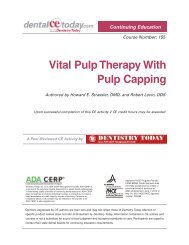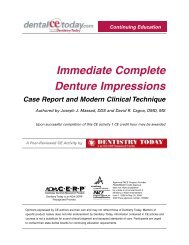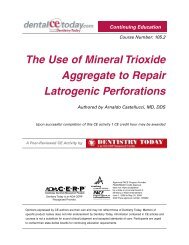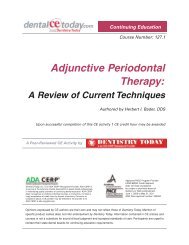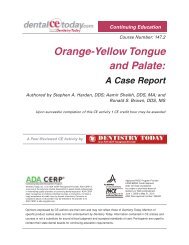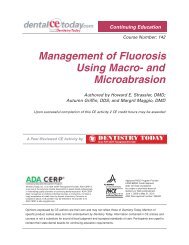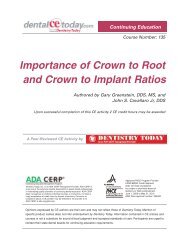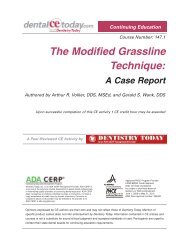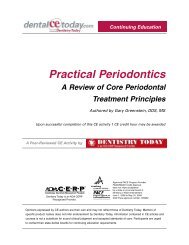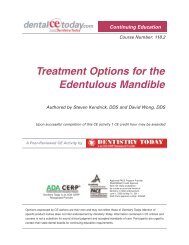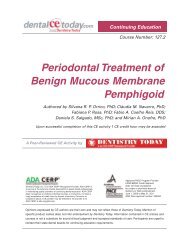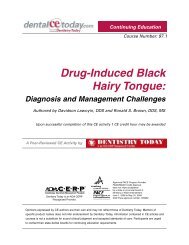Plaque Inhibition: The Science and Application of ... - DentalCEToday
Plaque Inhibition: The Science and Application of ... - DentalCEToday
Plaque Inhibition: The Science and Application of ... - DentalCEToday
Create successful ePaper yourself
Turn your PDF publications into a flip-book with our unique Google optimized e-Paper software.
Continuing Education<br />
Course Number: 146<br />
<strong>Plaque</strong> <strong>Inhibition</strong>:<br />
<strong>The</strong> <strong>Science</strong> <strong>and</strong> <strong>Application</strong><br />
<strong>of</strong> Oral Rinses<br />
Authored by Richard Demke, DDS<br />
Upon successful completion <strong>of</strong> this CE activity 2 CE credit hours may be awarded<br />
A Peer-Reviewed CE Activity by<br />
Dentistry Today, Inc, is an ADA CERP Recognized Provider. ADA CERP is<br />
a service <strong>of</strong> the American Dental Association to assist dental pr<strong>of</strong>essionals<br />
in indentifying quality providers <strong>of</strong> continuing dental education. ADA CERP<br />
does not approve or endorse individual courses or instructors, nor does it<br />
imply acceptance <strong>of</strong> credit hours by boards <strong>of</strong> dentistry. Concerns or<br />
complaints about a CE provider may be directed to the provider or to<br />
ADA CERP at ada.org/goto/cerp.<br />
Approved PACE Program Provider<br />
FAGD/MAGD Credit Approval<br />
does not imply acceptance<br />
by a state or provincial board <strong>of</strong><br />
dentistry or AGD endorsement.<br />
June 1, 2009 to May 31, 2012<br />
AGD Pace approval number: 309062<br />
Opinions expressed by CE authors are their own <strong>and</strong> may not reflect those <strong>of</strong> Dentistry Today. Mention <strong>of</strong><br />
specific product names does not infer endorsement by Dentistry Today. Information contained in CE articles <strong>and</strong><br />
courses is not a substitute for sound clinical judgment <strong>and</strong> accepted st<strong>and</strong>ards <strong>of</strong> care. Participants are urged to<br />
contact their state dental boards for continuing education requirements.
<strong>Plaque</strong> <strong>Inhibition</strong>: <strong>The</strong> <strong>Science</strong> <strong>and</strong><br />
<strong>Application</strong> <strong>of</strong> Oral Rinses<br />
Effective Date: 02/1/2012 Expiration Date: 02/1/2015<br />
LEARNING OBJECTIVES<br />
After participating in this CE activity, the individual will learn:<br />
• <strong>The</strong> fundamentals <strong>of</strong> plaque bi<strong>of</strong>ilm <strong>and</strong> the role <strong>of</strong> oral<br />
rinses in plaque inhibition.<br />
• <strong>Plaque</strong> control <strong>and</strong> treatment options currently available.<br />
ABOUT THE AUTHOR<br />
Dr. Demke received his DDS degree<br />
from Marquette Dental School, <strong>and</strong> BS<br />
degree in science from the University <strong>of</strong><br />
Wisconsin. He maintained a private<br />
practice in central Wisconsin <strong>and</strong> created<br />
a company to commercialize dental<br />
education booklets he wrote <strong>and</strong> produced. He spent 2<br />
years with Siemens in the development <strong>of</strong> nuclear medicine<br />
devices, <strong>and</strong> 13 years at GC America as the vice president<br />
<strong>of</strong> research <strong>and</strong> development. He can be reached at<br />
richard.demke@us.sunstar.com.<br />
Disclosure: Dr. Demke is currently the senior director<br />
<strong>of</strong> technology <strong>and</strong> new product development for Sunstar<br />
Americas.<br />
INTRODUCTION<br />
<strong>The</strong> purpose <strong>of</strong> this article is to inform dental clinicians<br />
about the fundamentals <strong>of</strong> plaque bi<strong>of</strong>ilm, at-home<br />
treatment <strong>and</strong> control options currently available, the role <strong>of</strong><br />
oral health rinses, <strong>and</strong> how <strong>and</strong> why mouthrinses should be<br />
applied in daily practice to provide more effective treatment<br />
<strong>and</strong> improved outcomes regarding periodontal disease.<br />
THE PREVALENCE OF PERIODONTAL DISEASE<br />
<strong>The</strong> prevalence <strong>of</strong> all forms <strong>of</strong> periodontal disease in the<br />
United States is approximately 75%, 1 <strong>and</strong> recent research by<br />
the Amer ican Academy <strong>of</strong> Periodontology <strong>and</strong> US Centers for<br />
Disease Control <strong>and</strong> Prevention suggests that periodontal<br />
disease prevalence rates may have been underestimated by<br />
1<br />
Continuing Education<br />
as much as 50%. 1<br />
Periodontal disease is a bacterial infection known to be<br />
caused by the effects <strong>of</strong> certain pathogenic bacteria that<br />
colonize the oral cavity. <strong>The</strong> early form <strong>of</strong> periodontal disease,<br />
gingivitis, has the potential to cause gingival inflammation <strong>and</strong><br />
bleeding. Gingivitis is plaque induced <strong>and</strong> initiated by a hostinflammatory<br />
response to maturing plaque bi<strong>of</strong>ilm, which is the<br />
primary etiological factor for gingival inflammation. 2 If left<br />
untreated, the disease may progress to periodontitis, which<br />
may lead to tissue recession, bone loss, <strong>and</strong> tooth loss.<br />
Advanced stages <strong>of</strong> periodontitis have been linked to systemic<br />
diseases, such as cardiovascular disease <strong>and</strong> diabetes. 3-5<br />
Dental bi<strong>of</strong>ilm is a living community <strong>of</strong> bacteria comprised<br />
<strong>of</strong> millions <strong>of</strong> cells that possess vigorous metabolic <strong>and</strong><br />
reproductive attributes. Bi<strong>of</strong>ilm grows as a complex, 3dimensional,<br />
self-protective, <strong>and</strong> sticky structure that is built<br />
up in layers (Figure 1). Bi<strong>of</strong>ilm consists <strong>of</strong> different species <strong>of</strong><br />
bacteria, notably Actinobaccillus actinomycetemcomitans,<br />
Streptococcus mutans, Fusobacterium nucleatum,<br />
Treponema denticola, Porphyro monas gingivalis, <strong>and</strong><br />
Tannerella forsythus. 6-8 <strong>The</strong>se species <strong>of</strong> bacteria are built up<br />
sequentially in layers, which enable them to interact <strong>and</strong><br />
cooperate with each other using various forms <strong>of</strong><br />
communication. Chemical signals are the most common<br />
method; however, electrical signals <strong>and</strong> the exchange <strong>of</strong><br />
genetic material have also been documented. <strong>The</strong> signals are<br />
specific, organized, <strong>and</strong> timed according to conditions in the<br />
oral cavity that favor colonization <strong>of</strong> subsequent bacterial<br />
species (Figure 2). <strong>The</strong>se bacteria facilitate the arrival <strong>of</strong> other<br />
bacteria by providing diverse adhesion sites, called coadhesion<br />
<strong>and</strong> co-aggregation. 6-8 Some species are not able<br />
to attach to a surface on their own, but are <strong>of</strong>ten able to<br />
anchor themselves to the bi<strong>of</strong>ilm matrix or directly to other<br />
bacteria. Once a bi<strong>of</strong>ilm colony has formed in the mouth, it<br />
releases chemicals <strong>and</strong> enzymes that signal other bacteria to<br />
join the colony. 6<br />
<strong>The</strong> challenge, therefore, is to disrupt the colonization,<br />
proliferation, <strong>and</strong> sequential layering <strong>of</strong> bi<strong>of</strong>ilm in order to<br />
interrupt the development <strong>and</strong> progression <strong>of</strong> periodontal<br />
disease. 9 During the past 200 years, various means have<br />
been devised with varying degrees <strong>of</strong> success, which is<br />
largely determined by the effectiveness <strong>of</strong> the pa tient’s oral<br />
care regimen.
CURRENT TOOLS AND<br />
RESOURCES TO INHIBIT<br />
PLAQUE<br />
Perhaps the most common means<br />
<strong>of</strong> plaque control, or more specifically,<br />
bi<strong>of</strong>ilm disruption, has been<br />
the daily <strong>and</strong> proper use <strong>of</strong> a<br />
toothbrush. 10,11 William Addis <strong>of</strong><br />
Engl<strong>and</strong> is believed to have<br />
produced the first mass-produced<br />
toothbrush in 1780, <strong>and</strong> the first<br />
American to patent a toothbrush<br />
was H.N. Wadsworth in 1857. 12<br />
Toothbrushes, however, are not<br />
always effective in cleaning<br />
interproximal surfaces, as these<br />
areas are beyond the reach <strong>of</strong><br />
most toothbrush bristles. In<br />
addition, gingival sulci are <strong>of</strong>ten not<br />
cleaned as well as desired due to<br />
the individual’s brushing technique.<br />
Dental floss has been proven<br />
highly effective in disrupting bi<strong>of</strong>ilm<br />
in interproximal areas, including<br />
portions <strong>of</strong> the sulcus; however, its<br />
effectiveness is technique sensitive <strong>and</strong> dependent on the<br />
patient’s skill, frequency <strong>of</strong> use, <strong>and</strong> motivation. <strong>The</strong> ADA<br />
statistics indicate that only 11% to 51% <strong>of</strong> people in developed<br />
countries claim to use dental floss or some other interdental<br />
cleaning device. 13-17<br />
Another time-tested plaque re moval implement is the<br />
wooden toothpick. Re cent advances in synthetic materials <strong>and</strong><br />
design have provided new s<strong>of</strong>t picks <strong>and</strong> nylon bristle brushes,<br />
which improve the ability to access tight interproximal spaces.<br />
<strong>The</strong>se advancements also caused their name to change to<br />
“interdental cleaners,” which is more descriptive <strong>of</strong> their<br />
function. Interdental cleaners can be effective ad juncts to other<br />
mechanical means <strong>of</strong> bio film disruption if used correctly <strong>and</strong><br />
regularly. Some interdental cleaners have rows <strong>of</strong> s<strong>of</strong>t, tiny<br />
bristles that can break up <strong>and</strong> sweep away supraginvigal bio -<br />
film between teeth, around <strong>and</strong> under fixed prosthodontic <strong>and</strong><br />
orthodontic appliances. Examples <strong>of</strong> interdental cleaners<br />
featuring small bristles are GUM Go-Betweens Proxabrush<br />
Continuing Education<br />
<strong>Plaque</strong> <strong>Inhibition</strong>: <strong>The</strong> <strong>Science</strong> <strong>and</strong> <strong>Application</strong> <strong>of</strong> Oral Rinses<br />
Figure 1. <strong>The</strong> attachment <strong>and</strong> progression <strong>of</strong> dental bi<strong>of</strong>ilm. (Used with permission from MSU Center for<br />
Bi<strong>of</strong>ilm Engineering.)<br />
Figure 2. Examples <strong>of</strong> later colonizing bacteria: Virulent, tissue-invasive, causative for periodontitis.<br />
2<br />
Clean ers (Sunstar Americas), <strong>and</strong> the Oral-B Interdental<br />
Brush System (Oral-B).<br />
All <strong>of</strong> the aforementioned devices are useful <strong>and</strong><br />
effective on hard tissues <strong>and</strong>, to a lesser extent, gingiva.<br />
However, due to their designs, these devices are unsuitable<br />
for cleaning the sensitive oral mucosa, which can harbor<br />
more bacteria than teeth <strong>and</strong> gums combined. Mechanical<br />
methods <strong>of</strong> oral hygiene are targeted only toward tooth<br />
surfaces <strong>and</strong> the dentogingival margins (approximately<br />
10% to 20% <strong>of</strong> the total oral surface area), <strong>and</strong> do not act<br />
on the mucosal surfaces <strong>of</strong> the oral cavity. <strong>The</strong>refore, the<br />
remaining 80% to 90% <strong>of</strong> uncleaned s<strong>of</strong>t tissues can rapidly<br />
reseed the mechanically cleaned areas with their ample<br />
reserves <strong>of</strong> living bacteria; unstimulated saliva contains 50<br />
million to 100 million bacteria per mL. 18,19 <strong>The</strong>refore, it is<br />
necessary to address these large bacterial reserves in<br />
order to reduce or eliminate their potential to rapidly<br />
repopulate the teeth <strong>and</strong> gingival surfaces.
Advent <strong>of</strong> Mouthrinse<br />
In 1879, Drs. Joseph Lawrence <strong>and</strong> Jordan<br />
Wheat Lambert developed a liquid antiseptic<br />
formula for use as a surgical disinfectant <strong>and</strong><br />
named it after Sir Joseph Lister, an English<br />
physician famous for performing the first<br />
antiseptic surgery in 1865. In 1884, the<br />
Lambert Company began to manufacture <strong>and</strong><br />
market LISTERINE products to the medical<br />
community as a multipurpose antiseptic. In<br />
1895, the Lambert Company extended the<br />
sale <strong>of</strong> LISTERINE disinfectant to the dental<br />
pr<strong>of</strong>ession as a powerful oral antiseptic. By<br />
1914, the formula had become popular <strong>and</strong><br />
was one <strong>of</strong> the first prescription products to be<br />
available over the counter, thereby founding<br />
the mouthwash category. 20 In the decades<br />
following, other manufacturers <strong>of</strong> oral care<br />
products developed cosmetic oral rinses that<br />
primarily freshened breath via antiseptic <strong>and</strong><br />
flavoring agents, but in the 1970s a separate<br />
classification <strong>of</strong> mouthrinses, called therapeutic<br />
mouthrinses, was established.<br />
ROLE OF THERAPEUTIC MOUTHRINSES<br />
Ongoing research in oral bacteriology has resulted in<br />
greater underst<strong>and</strong>ing <strong>of</strong> the ways aerobic <strong>and</strong> anaerobic<br />
bacteria enter the mouth, colonize, reproduce,<br />
communicate, <strong>and</strong> mutate. <strong>The</strong>rapeutic mouthrinses use<br />
various active ingredients to support the key benefits<br />
<strong>of</strong>fered, <strong>and</strong> are available over the counter <strong>and</strong> by<br />
prescription. Primary active ingredients <strong>of</strong> therapeutic<br />
mouthrinses include:<br />
1. A fixed mixture <strong>of</strong> essential oils (phenol compounds)<br />
2. Quaternary ammonium compounds (cetylpyridinium<br />
chloride [CPC])<br />
3. Bisbiguanide antiseptics (chlor hexidine gluconate<br />
[CHX]) by prescription only in the US <strong>and</strong> Canada.<br />
4. Amine alcohols (delmopinol hydrochloride).<br />
<strong>The</strong> active ingredients in therapeutic mouthrinses may<br />
control oral bi<strong>of</strong>ilm at differing stages <strong>of</strong> colonization, which<br />
includes colonization <strong>of</strong> the s<strong>of</strong>t tissues; however, therapeutic<br />
mouthrinses are most effective when used in combination with<br />
Continuing Education<br />
<strong>Plaque</strong> <strong>Inhibition</strong>: <strong>The</strong> <strong>Science</strong> <strong>and</strong> <strong>Application</strong> <strong>of</strong> Oral Rinses<br />
a<br />
Figure 3. (a) Placebo: tooth brushing, topical application <strong>of</strong> placebo, no toothpaste, plaque<br />
disclosant. (b) Including delmopinol: tooth brushing, topical application <strong>of</strong> delmopinol,<br />
toothpaste, plaque disclosant. (Photos courtesy <strong>of</strong> Dr. Richard Nagelberg.)<br />
a<br />
Figure 4. Periodontitis is a chronic, noncurable bacterial infection. Failure to prevent the<br />
progression <strong>of</strong> gingivitis (a) to periodontitis (b) condemns the patient to a lifetime <strong>of</strong> disease<br />
management. (Photo courtesy <strong>of</strong> Dr. Richard Nagelberg.)<br />
3<br />
b<br />
b<br />
other oral care procedures. Mouthrinses are not intended to<br />
replace mechanical attempts to remove/disrupt organisms <strong>and</strong><br />
colonies on tooth surfaces <strong>and</strong> gums, but rather to provide an<br />
adjunctive means to achieve greater <strong>and</strong> more consistent<br />
reductions in plaque <strong>and</strong> gingival inflammation.<br />
<strong>The</strong>rapeutic mouthrinses provide an additional level <strong>of</strong><br />
effective care adjunctive to toothbrushing, interproximal<br />
cleaning, <strong>and</strong> prophylaxis. In support <strong>of</strong> this, the rationale for<br />
daily use <strong>of</strong> antiplaque mouthrinses is tw<strong>of</strong>old: (1) as a<br />
component added adjunctively to mechanical oral hygiene<br />
regimens for the control <strong>and</strong> prevention <strong>of</strong> gingivitis, <strong>and</strong> (2) as<br />
a method for delivering antiplaque agents to mucosal sites<br />
throughout the mouth that harbor pathogenic bacteria<br />
capable <strong>of</strong> recolonizing su pra gingival <strong>and</strong> subgingival tooth<br />
surfaces. 21 <strong>The</strong> properties <strong>of</strong> anti plaque agents can be<br />
bactericidal, bacteriostatic, or antiadhesive, which may<br />
prevent plaque from developing on clean tooth surfaces.<br />
EFFICACY AND EFFICIENCY OF ORAL HEALTH RINSES<br />
IN CONTROLLING PLAQUE AND GINGIVITIS<br />
<strong>The</strong>rapeutic mouthrinses provide a variety <strong>of</strong> choices that
approach plaque control through different strategies to<br />
interrupt <strong>and</strong>/or reduce the proliferation <strong>of</strong> pathogenic bacteria<br />
<strong>and</strong> the progression <strong>of</strong> periodontal disease. <strong>The</strong>se strategies<br />
range from adjunctive oral health maintenance to acute<br />
disease intervention. <strong>The</strong>re fore, the choice <strong>of</strong> mouthrinse may<br />
be informed <strong>and</strong> guided by the patient’s clinical needs <strong>and</strong><br />
tolerance <strong>of</strong> the formulation’s active <strong>and</strong> inactive ingredients.<br />
1. Essential oils/phenols. <strong>The</strong> most well-known<br />
mouthrinse with a phenol-related fixed mixture <strong>of</strong> essential<br />
oils formulation is LISTERINE (John son & Johnson). It<br />
contains Thymol (0.064%), eucalyptol (0.092%), menthol<br />
(0.042%), <strong>and</strong> methyl salicylate (0.060%). This combination<br />
is dispersed in a denatured alcohol vehicle (between 21.6%<br />
to 26.9%).<br />
Continuing Education<br />
<strong>Plaque</strong> <strong>Inhibition</strong>: <strong>The</strong> <strong>Science</strong> <strong>and</strong> <strong>Application</strong> <strong>of</strong> Oral Rinses<br />
4<br />
<strong>The</strong> mechanism <strong>of</strong> action is complex. At high<br />
concentrations, there is a disruption <strong>of</strong> the cell wall <strong>and</strong><br />
precipitation <strong>of</strong> cell proteins; at lower concentrations,<br />
essential (bacterial) enzymes are inhibited. This formulation<br />
can penetrate plaque bi<strong>of</strong>ilm <strong>and</strong> exert bactericidal activity.<br />
<strong>The</strong> bacterial load is reduced with concomitant decrease in<br />
plaque mass <strong>and</strong> pathogenicity. 22<br />
2. Quaternary ammonium compounds (CPC). CPC is a<br />
cationic (positively charged) surface-active agent that has a<br />
broad antimicrobial spectrum <strong>of</strong> activity that involves the<br />
rapid destruction <strong>of</strong> Gram-positive patho gens <strong>and</strong> yeasts. An<br />
example <strong>of</strong> a CPC-containing therapeutic mouthrinse is<br />
Crest Pro-Health Multi-Protection Rinse (Procter & Gamble).<br />
Crest Pro-Health contains high bio available CPC (0.07%) in<br />
Table 1. Indications <strong>and</strong> Contraindications for 4 Representative Products as set Forth by <strong>The</strong>ir Respective Manufacturers<br />
Product Name LISTERINE Antiseptic Crest Pro-Health PERIDEX Chlorhexidine GUM PerioShield<br />
Multi-Protection Rinse Gluconate (CHX) 0.12% Oral Health Rinse<br />
Oral Rinse<br />
Active Ingredient(s) Fixed combination Quaternary ammonium CHX Amine alcohols/delmopinol<br />
<strong>of</strong> 4 essential oils a compounds/cetylpyridinium 0.12% hydrochloride 0.2%<br />
chloride 0.07%<br />
Primary Mode <strong>of</strong> Action Antimicrobial Antimicrobial Antimicrobial Antiadherent<br />
Indications Kills germs that Antigingivitis/antiplaque For use between dental visits Helps prevent <strong>and</strong> treat<br />
cause bad breath, rinse; fights bad breath; as part <strong>of</strong> a pr<strong>of</strong>essional gingivitis; recommended for<br />
plaque, <strong>and</strong> gingivitis. alcohol free. program for the treatment patients with heavy plaque<br />
<strong>of</strong> gingivitis as characterized <strong>and</strong> chronic gum<br />
by redness <strong>and</strong> swelling inflammation.<br />
<strong>of</strong> the gingivae, including<br />
gingival bleeding upon probing. b<br />
Contraindications Not for patients younger Not for patients younger Should not be used by Individuals with known<br />
than age 6 years. than age 12 years. persons who are known to hypersensitivity to any <strong>of</strong> the<br />
be hypersensitive to ingredients; children under<br />
CHX, or other age 12 years or pregnant<br />
formula ingredients. women. c<br />
Adverse Reactions Increase in staining<br />
<strong>of</strong> teeth <strong>and</strong> other oral<br />
surfaces; increase in calculus<br />
formation; alteration <strong>of</strong><br />
taste perception.<br />
a Thymol 0.064%, eucalyptol 0.092%, methyl salicylate 0.060%, menthol 0.042%, solubilized in 21.6% to 26.9% denatured alcohol.<br />
b CHX Oral Rinse has not been tested among patients with acute necrotizing ulcerative gingivitis.<br />
c Due to limited testing <strong>of</strong> this product on these populations.
an alcohol-free formulation.<br />
<strong>The</strong> mode <strong>of</strong> action is through the disruption <strong>of</strong> the cell<br />
membrane function, leakage <strong>of</strong> cytoplasmic material, <strong>and</strong><br />
collapse <strong>of</strong> intracellular equilibrium. <strong>The</strong> substantivity (or<br />
duration <strong>of</strong> effectiveness) <strong>of</strong> CPC is reported to be between<br />
3 <strong>and</strong> 5 hours, at least in part due to its cationic nature. 23<br />
It is significant to note that not all CPC-containing<br />
mouthrinses provide the same degree <strong>of</strong> clinical benefit due to<br />
the bioavailability <strong>of</strong> CPC. <strong>The</strong> formulation <strong>of</strong> the vehicle<br />
ingredients can have a significant impact on the bioavailability<br />
<strong>of</strong> CPC. Increased bio availability is associated with higher<br />
probability <strong>of</strong> effectiveness, greater antiplaque activity, <strong>and</strong><br />
greater reductions in gingivitis; decreased bioavailability <strong>and</strong><br />
lower concentrations <strong>of</strong> CPC are associated with cosmetic<br />
claims alone, such as in vitro germ killing (<strong>and</strong>) fresh breath. 19<br />
3. Bisbiguanide antiseptics (CHX). CHX has been widely<br />
used in medicine <strong>and</strong> surgery for presurgical disinfection<br />
since the 1940s, <strong>and</strong> was first investigated for effectiveness<br />
in the oral cavity in 1970. 24 It is considered the “gold st<strong>and</strong>ard”<br />
therapeutic mouth rinse. Or iginally, this prescription-only<br />
Continuing Education<br />
<strong>Plaque</strong> <strong>Inhibition</strong>: <strong>The</strong> <strong>Science</strong> <strong>and</strong> <strong>Application</strong> <strong>of</strong> Oral Rinses<br />
Table 2. Comparison <strong>of</strong> <strong>Plaque</strong> <strong>and</strong> Gingivitis Scores Among 4 Representative Mouthrinse Types<br />
Reductions in <strong>Plaque</strong> <strong>and</strong> Gingivitis in 6-month Clinical Studies a<br />
Active Ingredient Maximum Maximum Maximum Bleeding Reference<br />
<strong>Plaque</strong> Gingivitis on Probing<br />
Reduction Reduction Reduction<br />
(%) b (%) b (%) b<br />
Chlorhexidine 60.9% 42.5% 77% 30, 31, 35, 39<br />
0.12%<br />
Fixed Combination 56.3% 35.9% 69.8% 11, 31-35, 37, 39<br />
<strong>of</strong> Essential Oils c<br />
Delmopinol 35% 18% 57% 29, 35, 37, 38<br />
Hydrochloride<br />
0.2%<br />
Cetylpyridinium 15.8% 15.4% 33.3% 36<br />
Chloride<br />
0.07%<br />
a Comparison between agents is inadvisable due to differences in study design <strong>and</strong> indices reported.<br />
b Compared with negative control at 6 months.<br />
c Thymol 0.064%, eucalyptol 0.092%, methyl salicylate 0.060%, menthol 0.042%, solubilized in 21.6% to 26.9% denatured alcohol.<br />
5<br />
mouth rinse (in the US <strong>and</strong> Canada) was formulated with<br />
alcohol (approximately 11.6%), <strong>and</strong> now alcohol-free<br />
formulations are available. An example <strong>of</strong> an alcoholcontaining<br />
CHX 0.12% mouth rinse is PERIDEX (3M ESPE),<br />
while an example <strong>of</strong> an alcohol-free CHX 0.12% mouthrinse<br />
is GUM CHX Oral Rinse USP, 0.12% (Sunstar Americas).<br />
<strong>The</strong> CHX molecule is a strong base, with 2 positive charges<br />
(dicationic) at pH levels greater than 3.5. 25 <strong>The</strong>se 2 positive<br />
charges make CHX extremely interactive with anions <strong>and</strong> are<br />
the basis <strong>of</strong> its clinical effectiveness as well as its unwanted<br />
effects, such as tooth staining.<br />
<strong>The</strong> primary mode <strong>of</strong> action is thought to occur against the<br />
cell wall, which is negatively charged. <strong>The</strong> positively charged<br />
CHX molecule is rapidly attracted to the negatively charged<br />
cell surface, <strong>and</strong> binds via adsorption to oral surfaces, the<br />
pellicle, <strong>and</strong> saliva. At low concentrations, the integrity <strong>of</strong> the<br />
cell membrane is altered <strong>and</strong> leads to increased permeability<br />
<strong>and</strong> leakage <strong>of</strong> low molecular weight intracellular contents, but<br />
this is reversible <strong>and</strong> the cell can recover. This effect is<br />
considered bacteriostatic. At higher concentrations, there is
educed leakage <strong>of</strong> low molecular weight intracellular contents,<br />
but coagulation along with precipitation <strong>of</strong> the cytoplasm<br />
occurs, which is irreversible <strong>and</strong> therefore the effect is<br />
considered bactericidal. 26<br />
4. Amine alcohols (delmopinol hydro chloride). A new<br />
generation <strong>of</strong> anti plaque <strong>and</strong> antigingivitis agents has been<br />
established that inhibits or disrupts the formation <strong>of</strong> plaque<br />
while possessing little, if any, effect on the bacteria, thus<br />
avoiding disruption to the balance <strong>of</strong> bacterial flora found in<br />
a healthy mouth. Delmopinol hydro chloride (morpholinoethanol<br />
derivative) is an amine alcohol that functions as<br />
a surface-active agent shown to interact with pellicle<br />
constituents <strong>and</strong> inhibit glucan synthesis by S mutans. 27 It<br />
has little or no demonstrable effect on the bacteria, but it<br />
interferes with plaque/bi<strong>of</strong>ilm matrix formation. <strong>The</strong> nascent<br />
bio film mass, being loosely adherent, produces a reduction<br />
in the proportion <strong>of</strong> dextran-producing cocci. 28 <strong>The</strong><br />
interference with plaque matrix formation leads to the<br />
plaque deposit being less sticky <strong>and</strong> less dense, which<br />
makes it easier to remove through mechanical means.<br />
An example <strong>of</strong> a delmopinol hy dro chloride oral rinse is<br />
GUM PerioShield Oral Health Rinse (Sunstar Americas).<br />
Per ioShield contains delmopinol hydro chloride (0.2%),<br />
which studies have shown to be effective against plaque<br />
<strong>and</strong> gingivitis in short-term studies on individuals with no<br />
oral hy giene, as well as in long-term, home-use studies.<br />
<strong>The</strong> short-term studies on individuals with no oral hygiene<br />
showed plaque inhibition close to that <strong>of</strong> CHX. 29 (Figures<br />
3a to 4b) (Ta bles 1 <strong>and</strong> 211,29-39 ).<br />
ORAL HEALTH RINSES RECOMMENDED ACCORDING<br />
TO PATIENT NEEDS<br />
<strong>The</strong> clinician’s recommendation <strong>of</strong> a therapeutic mouthrinse is<br />
determined by the pa tient’s clinical needs <strong>and</strong> tolerance <strong>of</strong> the<br />
product’s ingredients, including sensory perceptions, as this<br />
can directly affect patient compliance. In general, the<br />
choice <strong>of</strong> mouthrinse may be based upon the pa tient’s state<br />
<strong>of</strong> oral health. For example, for patients with acute gingivitis,<br />
the clinician may prescribe a CHX rinse, typically for 2 to 4<br />
weeks. As the pa tient responds <strong>and</strong> oral health improves, the<br />
clinician may recommend a nonCHX rinse, such as a mixture<br />
<strong>of</strong> essential oils or CPC formulation if bacterial control is still<br />
Continuing Education<br />
<strong>Plaque</strong> <strong>Inhibition</strong>: <strong>The</strong> <strong>Science</strong> <strong>and</strong> <strong>Application</strong> <strong>of</strong> Oral Rinses<br />
6<br />
de sired, or a delmopinol rinse to inhibit the adhesion <strong>of</strong><br />
plaque <strong>and</strong> facilitate easier re moval. As a nonantimicrobial<br />
rinse, delmopin ol helps maintain healthy oral flora, which<br />
may prevent po tential overgrowths <strong>of</strong> antimicrobial-resistant<br />
strains. This prop erty enables long-term use <strong>of</strong> delmopinol<br />
following short-term treatment with CHX, as well as<br />
treatment without CHX for less severe gingivitis patients<br />
where a strong antibacterial effect may not be indicated.<br />
Patient Acceptance<br />
After ruling out allergic reactions to the ingredients <strong>of</strong> any<br />
mouthrinse, the goal <strong>of</strong> the clinician is to recommend a<br />
mouthrinse that is: (1) effective for the treatment <strong>of</strong> the<br />
patient’s condition, (2) tolerated by the patient for the<br />
recommended duration <strong>and</strong> frequency <strong>of</strong> use, <strong>and</strong> (3) has<br />
acceptable side effects.<br />
<strong>The</strong> patient’s sensory perceptions play a key role in<br />
acceptance; therefore, the clinician should an ticipate the<br />
possible rejection <strong>of</strong> a recommended product based on its<br />
odor, flavor, inclusion <strong>of</strong> certain ingredients, or “mouth feel”<br />
while being used. For example, the presence <strong>of</strong> alcohol in a<br />
product may or may not be a factor in patient ac ceptance.<br />
Since alcohol is <strong>of</strong> no therapeutic benefit, alcohol containing<br />
formulations may be undesirable for diabetics, nursing<br />
mothers, al coholics, <strong>and</strong> those who choose to avoid alcohol for<br />
any reason. For such pa tients, acceptance <strong>and</strong> compliance<br />
may be im proved by recommending alcohol-free formulations.<br />
In addition, tooth staining, taste alteration, stinging, <strong>and</strong><br />
tongue numbing are factors that should be considered in<br />
regard to patient acceptance. While some patients may<br />
consider these effects to be incidental, easily tolerated, or<br />
merely temporarily bothersome, others may con sider them<br />
unacceptable. <strong>The</strong>re fore the clinician should be prepared to<br />
recommend a different formulation when the patient’s<br />
sensory perceptions or negative experience with a pro duct<br />
threaten com pliance.<br />
SUMMARY AND CONCLUSION<br />
<strong>The</strong> adjunctive use <strong>of</strong> therapeutic mouthrinses provides a way<br />
<strong>of</strong> overcoming deficiencies in mechanical tooth cleaning.<br />
Through direct de struction <strong>of</strong> susceptible oral bacteria or<br />
through the prevention <strong>of</strong> bacterial adhesion <strong>and</strong> aggregation,
therapeutic mouthrinses are a well-accepted means <strong>of</strong><br />
interrupting the accumulation <strong>and</strong> progression <strong>of</strong> oral bi<strong>of</strong>ilms,<br />
which in turn may interrupt or prevent the progression <strong>of</strong><br />
gingivitis. <strong>The</strong>refore, therapeutic mouthrinses play an<br />
important role in the treatment <strong>and</strong> prevention <strong>of</strong> gum disease<br />
<strong>and</strong> in the maintenance <strong>of</strong> oral health.<br />
REFERENCES<br />
1. Perio.org. Periodontal disease fact sheet.<br />
perio.org/consumer/disease_facts.htm. Accessed<br />
July 14, 2011.<br />
2. Löe H, <strong>The</strong>ilade E, Jensen SB. Experimental gingivitis<br />
in man. J Periodontol. 1965;36:177-187.<br />
3. Beck JD, Offenbacher S, Williams R, et al. Periodontitis:<br />
a risk factor for coronary heart disease? Ann Periodontol.<br />
1998;3:127-141.<br />
4. Iacopino AM. Periodontitis <strong>and</strong> diabetes interrelationships:<br />
role <strong>of</strong> inflammation. Ann Perio dontol. 2001;6:125-137.<br />
5. Desvarieux M, Demmer RT, Rundek T, et al. Perio dontal<br />
microbiota <strong>and</strong> carotid intima-media thickness: the Oral<br />
Infections <strong>and</strong> Vascular Disease Epi demiology Study<br />
(INVEST). Circulation. 2005;111:576-582.<br />
6. Diaz PI, Chalmers NI, Rickard AH, et al. Molecular<br />
characterization <strong>of</strong> subject-specific oral micr<strong>of</strong>lora<br />
during initial colonization <strong>of</strong> enamel. Appl Environ<br />
Microbiol. 2006;72:2837-2848.<br />
7. Scheie AA, Petersen FC. <strong>The</strong> bi<strong>of</strong>ilm concept:<br />
consequences for future prophylaxis <strong>of</strong> oral diseases?<br />
Crit Rev Oral Biol Med. 2004;15:4-12.<br />
8. Marsh PD. Dental plaque: biological significance <strong>of</strong> a<br />
bi<strong>of</strong>ilm <strong>and</strong> community life-style. J Clin Periodontol.<br />
2005;32(suppl 6):7-15.<br />
9. Haffajee AD, Arguello EI, Ximenez-Fyvie LA, et al.<br />
Controlling the plaque bi<strong>of</strong>ilm. Int Dent J.<br />
2003;53(suppl 3):191-199.<br />
10. Zimmer S, Kolbe C, Kaiser G, et al. Clinical efficacy <strong>of</strong><br />
flossing versus use <strong>of</strong> antimicrobial rinses. J Periodontol.<br />
2006;77:1380-1385.<br />
11. Sharma N, Charles CH, Lynch MC, et al. Adjunctive<br />
benefit <strong>of</strong> an essential oil-containing mouthrinse in<br />
reducing plaque <strong>and</strong> gingivitis in patients who brush <strong>and</strong><br />
floss regularly: a six-month study. J Am Dent Assoc.<br />
2004;135:496-504.<br />
12. Library <strong>of</strong> Congress. Everyday mysteries: Who<br />
invented the toothbrush <strong>and</strong> when was it invented?<br />
Continuing Education<br />
<strong>Plaque</strong> <strong>Inhibition</strong>: <strong>The</strong> <strong>Science</strong> <strong>and</strong> <strong>Application</strong> <strong>of</strong> Oral Rinses<br />
7<br />
loc.gov/rr/scitech/mysteries/tooth.html. Accessed<br />
November 21, 2011.<br />
13. Christensen LB, Petersen PE, Krustrup U, et al. Selfreported<br />
oral hygiene practices among adults in<br />
Denmark. Community Dent Health. 2003;20:229-235.<br />
14. Segelnick SL. A survey <strong>of</strong> floss frequency, habit <strong>and</strong><br />
technique in a hospital dental clinic & private periodontal<br />
practice. N Y State Dent J. 2004;70:28-33.<br />
15. American Dental Association. 2003 public opinion<br />
survey: Oral Health <strong>of</strong> the U.S. Population. Chicago,<br />
IL: American Dental Association; 2004.<br />
16. Bakdash B. Current patterns <strong>of</strong> oral hygiene product<br />
use <strong>and</strong> practices. Periodontol 2000. 1995;8:11-14.<br />
17. Hugoson A, Norderyd O, Slotte C, et al. Oral hygiene<br />
<strong>and</strong> gingivitis in a Swedish adult population 1973,<br />
1983 <strong>and</strong> 1993. J Clin Periodontol. 1998;25:807-812.<br />
18. Imrey PB, Chilton NW, Pihlstrom BL, et al. Rec -<br />
ommended revisions to American Dental Asso ciation<br />
guidelines for acceptance <strong>of</strong> chemotherapeutic<br />
products for gingivitis control. Report <strong>of</strong> the Task Force<br />
on Design <strong>and</strong> Analysis in Dental <strong>and</strong> Oral Research<br />
to the Council on <strong>The</strong>r apeu tics <strong>of</strong> the Amer ican Dental<br />
Association. J Perio dontal Res. 1994;29:299-304.<br />
19. US Food <strong>and</strong> Drug Administration. Oral health care<br />
drug products for over-the-counter human use;<br />
antigingivitis/antiplaque drug products; es tablishment<br />
<strong>of</strong> a monograph; proposed rules. Fed Regist.<br />
2003;68:32231-32287.<br />
20. History <strong>of</strong> Listerine. listerine.com.sg/history-<strong>of</strong>listerine.html.<br />
Accessed July 13, 2011.<br />
21. Barnett ML. <strong>The</strong> rationale for the daily use <strong>of</strong> an<br />
antimicrobial mouthrinse. J Am Dent Assoc.<br />
2006;137(suppl):16S-21S.<br />
22. Fine DH, Letizia J, M<strong>and</strong>el ID. <strong>The</strong> effect <strong>of</strong> rinsing<br />
with Listerine antiseptic on the properties <strong>of</strong><br />
developing dental plaque. J Clin Periodontol.<br />
1985;12:660-666.<br />
23. Roberts WR, Addy M. Comparison <strong>of</strong> the in vivo <strong>and</strong><br />
in vitro antibacterial properties <strong>of</strong> antiseptic<br />
mouthrinses containing chlorhexidine, alexidine, cetyl<br />
pyridinium chloride <strong>and</strong> hexetidine. Rel evance to mode<br />
<strong>of</strong> action. J Clin Periodontol. 1981;8:295-310.<br />
24. Löe H, Schiott CR. <strong>The</strong> effect <strong>of</strong> mouthrinses <strong>and</strong><br />
topical application <strong>of</strong> chlorhexidine on the<br />
development <strong>of</strong> dental plaque <strong>and</strong> gingivitis in man.<br />
J Periodontal Res. 1970;5:79-83.
25. Denton GW. Chlorhexidine. In: Block SS, ed.<br />
Disinfection, Sterilization, <strong>and</strong> Preservation. 4th ed.<br />
Philadelphia, PA: Lea <strong>and</strong> Febiger; 1991:274-289.<br />
26. Jones CG. Chlorhexidine: is it still the gold st<strong>and</strong>ard?<br />
Periodontol 2000. 1997;15:55-62.<br />
27. Rundegren J, Simonsson T, Petersson L, et al. Effect<br />
<strong>of</strong> delmopinol on the cohesion <strong>of</strong> glucan-containing<br />
plaque formed by Streptococcus mutans in a flow cell<br />
system. J Dent Res. 1992;71:1792-1796.<br />
28. Elworthy AJ, Edgar R, Moran J, et al. A 6-month<br />
home-usage trial <strong>of</strong> 0.1% <strong>and</strong> 0.2% delmopinol<br />
mouthwashes (II). Effects on the plaque micr<strong>of</strong>lora.<br />
J Clin Periodontol. 1995;22:527-532.<br />
29. Claydon N, Hunter L, Moran J, et al. A 6-month homeusage<br />
trial <strong>of</strong> 0.1% <strong>and</strong> 0.2% delmopinol<br />
mouthwashes (I). Effects on plaque, gingivitis,<br />
supragingival calculus <strong>and</strong> tooth staining. J Clin<br />
Periodontol. 1996;23(3 pt 1):220-228.<br />
30. Grossman E, Reiter G, Sturzenberger OP, et al. Sixmonth<br />
study <strong>of</strong> the effects <strong>of</strong> a chlorhexidine<br />
mouthrinse on gingivitis in adults. J Perio Res.<br />
1986;21(suppl):33-43.<br />
31. Overholser CD, Meiller TF, DePaola LG, et al.<br />
Comparative effects <strong>of</strong> 2 chemotherapeutic<br />
mouthrinses on the development <strong>of</strong> supragingival<br />
dental plaque <strong>and</strong> gingivitis. J Clin Periodontol.<br />
1990;17:575-579.<br />
32. Lamster IB, Alfano MC, Seiger MC, et al. <strong>The</strong> effect <strong>of</strong><br />
Listerine Antiseptic on reduction <strong>of</strong> existing plaque<br />
<strong>and</strong> gingivitis. Clin Prev Dent. 1983;5:12-16.<br />
Continuing Education<br />
<strong>Plaque</strong> <strong>Inhibition</strong>: <strong>The</strong> <strong>Science</strong> <strong>and</strong> <strong>Application</strong> <strong>of</strong> Oral Rinses<br />
8<br />
33. Gordon JM, Lamster IB, Seiger MC. Efficacy <strong>of</strong> Listerine<br />
antiseptic in inhibiting the development <strong>of</strong> plaque <strong>and</strong><br />
gingivitis. J Clin Periodontol. 1985;12:697-704.<br />
34. DePaola LG, Overholser CD, Meiller TF, et al.<br />
Chemotherapeutic inhibition <strong>of</strong> supragingival dental<br />
plaque <strong>and</strong> gingivitis development. J Clin Periodontol.<br />
1989;16:311-315.<br />
35. Charles CH, Sharma NC, Galustians HJ, et al.<br />
Comparative efficacy <strong>of</strong> an antiseptic mouthrinse <strong>and</strong><br />
an antiplaque/antigingivitis dentifrice. A six-month<br />
clinical trial. J Am Dent Assoc. 2001;132:670-675.<br />
36. Mankodi S, Bauroth K, Witt JJ, et al. A 6-month clinical<br />
trial to study the effects <strong>of</strong> a cetylpyridinium chloride<br />
mouthrinse on gingivitis <strong>and</strong> plaque. Am J Dent.<br />
2005;18(special issue):9A-14A.<br />
37. Lang NP, Hase JC, Grassi M, et al. <strong>Plaque</strong> formation<br />
<strong>and</strong> gingivitis after supervised mouthrinsing with<br />
0.2% delmopinol hydrochloride, 0.2% chlor hexidine<br />
digluconate <strong>and</strong> placebo for 6 months. Oral Dis.<br />
1998;4:105-113.<br />
38. Hase JC, Attström R, Edwardsson S, et al. 6-month<br />
use <strong>of</strong> 0.2% delmopinol hydrochloride in comparison<br />
with 0.2% chlorhexidine digluconate <strong>and</strong> placebo. (I).<br />
Effect on plaque formation <strong>and</strong> gingivitis. J Clin<br />
Periodontol. 1998;25:746-753.<br />
39. Charles CH, Mostler KM, Bartels LL, et al.<br />
Comparative antiplaque <strong>and</strong> antigingivitis<br />
effectiveness <strong>of</strong> a chlorhexidine <strong>and</strong> an essential oil<br />
mouthrinse: 6-month clinical trial. J Clin Periodontol.<br />
2004;31:878-884.
POST EXAMINATION INFORMATION<br />
To receive continuing education credit for participation in<br />
this educational activity you must complete the program<br />
post examination <strong>and</strong> receive a score <strong>of</strong> 70% or better.<br />
Traditional Completion Option:<br />
You may fax or mail your answers with payment to Dentistry<br />
Today (see Traditional Completion Information on following<br />
page). All information requested must be provided in order<br />
to process the program for credit. Be sure to complete your<br />
“Payment,” “Personal Certification Information,” “Answers,”<br />
<strong>and</strong> “Evaluation” forms. Your exam will be graded within 72<br />
hours <strong>of</strong> receipt. Upon successful completion <strong>of</strong> the postexam<br />
(70% or higher), a letter <strong>of</strong> completion will be mailed<br />
to the address provided.<br />
Online Completion Option:<br />
Use this page to review the questions <strong>and</strong> mark your<br />
answers. Return to dentalcetoday.com <strong>and</strong> sign in. If you<br />
have not previously purchased the program, select it from<br />
the “Online Courses” listing <strong>and</strong> complete the online<br />
purchase process. Once purchased the program will be<br />
added to your User History page where a Take Exam link<br />
will be provided directly across from the program title.<br />
Select the Take Exam link, complete all the program<br />
questions <strong>and</strong> Submit your answers. An immediate grade<br />
report will be provided. Upon receiving a passing grade,<br />
complete the online evaluation form. Upon submitting<br />
the form, your Letter Of Completion will be provided<br />
immediately for printing.<br />
General Program Information:<br />
Online users may log in to dentalcetoday.com any time in<br />
the future to access previously purchased programs <strong>and</strong><br />
view or print letters <strong>of</strong> completion <strong>and</strong> results.<br />
POST EXAMINATION QUESTIONS<br />
1. According the American Academy <strong>of</strong> Periodontology,<br />
the prevalence <strong>of</strong> periodontal disease in the United<br />
States is approximately:<br />
a. 25%.<br />
b. 40%.<br />
c. 50%.<br />
d. 75%.<br />
Continuing Education<br />
<strong>Plaque</strong> <strong>Inhibition</strong>: <strong>The</strong> <strong>Science</strong> <strong>and</strong> <strong>Application</strong> <strong>of</strong> Oral Rinses<br />
9<br />
2. Dental bi<strong>of</strong>ilm is composed <strong>of</strong>:<br />
a. Individual free-floating bacteria on the pellicle.<br />
b. One or more layers <strong>of</strong> bacteria attached to teeth <strong>and</strong><br />
s<strong>of</strong>t tissue.<br />
c. Calculus.<br />
d. Both a <strong>and</strong> c.<br />
3. Adequate tooth brushing <strong>and</strong> flossing may clean up<br />
to _______ <strong>of</strong> the total oral surfaces:<br />
a. 20%.<br />
b. 50%.<br />
c. 80%.<br />
d. 40%.<br />
4. Unstimulated saliva contains:<br />
a. 10 million to 50 million bacteria per liter.<br />
b. 25 million to 50 million bacteria per mL.<br />
c. 50 million to 100 million bacteria per mL.<br />
d. 75 million to 150 million bacteria per liter.<br />
5. Certain therapeutic mouthrinses can:<br />
a. Kill all bacteria in the oral cavity.<br />
b. Temporarily attenuate the growth <strong>of</strong> oral bacteria.<br />
c. Prevent the attachment <strong>and</strong> layering <strong>of</strong> bi<strong>of</strong>ilm.<br />
d. Both b <strong>and</strong> c.<br />
6. <strong>The</strong>rapeutic mouthrinses:<br />
a. Can replace mechanical methods <strong>of</strong> plaque removal.<br />
b. Are used as an adjunctive means to reduce plaque.<br />
c. Have no side effects when used as directed.<br />
d. All require a prescription.<br />
7. <strong>The</strong>rapeutic mouthrinses:<br />
a. May control the growth or layering <strong>of</strong> free-floating <strong>and</strong><br />
organized bi<strong>of</strong>ilm.<br />
b. May reach all tissues in the oral cavity.<br />
c. Achieve more consistent reductions in plaque.<br />
d. All <strong>of</strong> the above.<br />
8. <strong>The</strong> rationale for using therapeutic mouthrinses is/are:<br />
a. So the patient may omit flossing when mouthrinses<br />
are used as directed.<br />
b. To augment mechanical oral hygiene regimens <strong>and</strong><br />
deliver antiplaque agents.<br />
c. To allow for the nonsurgical treatment <strong>of</strong> periodontitis.<br />
d. Both b <strong>and</strong> c.
9. <strong>The</strong>rapeutic mouthrinses with a fixed mixture <strong>of</strong><br />
essential oils:<br />
a. Are bactericidal when used as directed.<br />
b. Prevent layering <strong>of</strong> bi<strong>of</strong>ilm when used as directed.<br />
c. Are bacteriostatic when used as directed.<br />
d. May stain teeth when used as directed.<br />
10. <strong>The</strong>rapeutic mouthrinses with high bioavailable<br />
cetylpyridinium chloride:<br />
a. Prevent layering <strong>of</strong> bi<strong>of</strong>ilm when used as directed.<br />
b. Are bactericidal <strong>and</strong> bacteriostatic when used as<br />
directed.<br />
c. Require a prescription from a doctor.<br />
d. Are bacteriostatic when used as directed.<br />
11. <strong>The</strong>rapeutic mouthrinses with chlorhexidine<br />
gluconate (CHX):<br />
a. Is the “gold st<strong>and</strong>ard” therapeutic mouthrinse.<br />
b. Contains a strong base with 2 positive charges at pH<br />
levels above 3.5.<br />
c. Are extremely interactive with anions.<br />
d. All <strong>of</strong> the above.<br />
12. <strong>The</strong>rapeutic mouthrinses with CHX:<br />
a. May be used indefinitely when used as directed.<br />
b. Prevent the attachment <strong>and</strong> layering <strong>of</strong> oral bi<strong>of</strong>ilm.<br />
c. Bind to the cell walls, which initiates its antibacterial<br />
mode <strong>of</strong> action.<br />
d. Do not require a doctor’s prescription in the United<br />
States.<br />
Continuing Education<br />
<strong>Plaque</strong> <strong>Inhibition</strong>: <strong>The</strong> <strong>Science</strong> <strong>and</strong> <strong>Application</strong> <strong>of</strong> Oral Rinses<br />
10<br />
13. <strong>The</strong>rapeutic mouthrinses with delmopinol<br />
hydrochloride:<br />
a. Prevent the attachment <strong>and</strong> layering <strong>of</strong> oral bi<strong>of</strong>ilm.<br />
b. Are bactericidal <strong>and</strong> bacteriostatic when used as<br />
directed.<br />
c. Disrupt the balance <strong>of</strong> oral flora.<br />
d. May not be used indefinitely when used as directed.<br />
14. <strong>The</strong>rapeutic mouthrinses with delmopinol<br />
hydrochloride:<br />
a. Have little or no demonstrable effect on oral bacteria.<br />
b. Interfere with plaque/bi<strong>of</strong>ilm matrix formation.<br />
c. Make plaque less sticky <strong>and</strong> easier to remove.<br />
d. All <strong>of</strong> the above.<br />
15. When should a dental pr<strong>of</strong>essional recommend a<br />
therapeutic mouthrinse?<br />
a. When a patient’s efforts at mechanical plaque<br />
removal are inadequate.<br />
b. Not until a patient has periodontitis.<br />
c. When a patient has poor plaque control <strong>and</strong> is under<br />
the age <strong>of</strong> 6 years.<br />
d. Both b <strong>and</strong> c.<br />
16. <strong>The</strong>rapeutic mouthrinses may work through:<br />
a. Inoculation <strong>of</strong> the oral cavity against microorganisms.<br />
b. Direct destruction <strong>of</strong> susceptible oral bacteria.<br />
c. Prevention <strong>of</strong> bacterial adhesion.<br />
d. Both b <strong>and</strong> c.
PROGRAM COMPLETION INFORMATION<br />
If you wish to purchase <strong>and</strong> complete this activity<br />
traditionally (mail or fax) rather than online, you must<br />
provide the information requested below. Please be sure to<br />
select your answers carefully <strong>and</strong> complete the evaluation<br />
information. To receive credit you must answer at least 12 <strong>of</strong><br />
the 16 questions correctly.<br />
Complete online at: dentalcetoday.com<br />
TRADITIONAL COMPLETION INFORMATION:<br />
Mail or fax this completed form with payment to:<br />
Dentistry Today<br />
Department <strong>of</strong> Continuing Education<br />
100 Passaic Avenue<br />
Fairfield, NJ 07004<br />
Fax: 973-882-3622<br />
PAYMENT & CREDIT INFORMATION:<br />
Examination Fee: $40.00 Credit Hours: 2.0<br />
Note: <strong>The</strong>re is a $10 surcharge to process a check drawn on<br />
any bank other than a US bank. Should you have additional<br />
questions, please contact us at (973) 882-4700.<br />
❏ I have enclosed a check or money order.<br />
❏ I am using a credit card.<br />
My Credit Card information is provided below.<br />
❏ American Express ❏ Visa ❏ MC ❏ Discover<br />
Please provide the following (please print clearly):<br />
Exact Name on Credit Card<br />
Credit Card # Expiration Date<br />
Signature<br />
Approved PACE Program Provider<br />
FAGD/MAGD Credit Approval<br />
does not imply acceptance<br />
by a state or provincial board <strong>of</strong><br />
dentistry or AGD endorsement.<br />
June 1, 2009 to May 31, 2012<br />
AGD Pace approval number: 309062<br />
Continuing Education<br />
<strong>Plaque</strong> <strong>Inhibition</strong>: <strong>The</strong> <strong>Science</strong> <strong>and</strong> <strong>Application</strong> <strong>of</strong> Oral Rinses<br />
Dentistry Today, Inc, is an ADA CERP Recognized<br />
Provider. ADA CERP is a service <strong>of</strong> the American<br />
Dental Association to assist dental pr<strong>of</strong>essionals in<br />
indentifying quality providers <strong>of</strong> continuing dental<br />
education. ADA CERP does not approve or endorse<br />
individual courses or instructors, nor does it imply<br />
acceptance <strong>of</strong> credit hours by boards <strong>of</strong> dentistry.<br />
Concerns or complaints about a CE provider may be<br />
directed to the provider or to ADA CERP at<br />
ada.org/goto/cerp.<br />
/<br />
11<br />
PERSONAL CERTIFICATION INFORMATION:<br />
Last Name (PLEASE PRINT CLEARLY OR TYPE)<br />
First Name<br />
Pr<strong>of</strong>ession / Credentials License Number<br />
Street Address<br />
Suite or Apartment Number<br />
City State Zip Code<br />
Daytime Telephone Number With Area Code<br />
Fax Number With Area Code<br />
E-mail Address<br />
ANSWER FORM: COURSE #: 146<br />
Please check the correct box for each question below.<br />
1. ❏ a ❏ b ❏ c ❏ d 9. ❏ a ❏ b ❏ c ❏ d<br />
2. ❏ a ❏ b ❏ c ❏ d 10. ❏ a ❏ b ❏ c ❏ d<br />
3. ❏ a ❏ b ❏ c ❏ d 11. ❏ a ❏ b ❏ c ❏ d<br />
4. ❏ a ❏ b ❏ c ❏ d 12. ❏ a ❏ b ❏ c ❏ d<br />
5. ❏ a ❏ b ❏ c ❏ d 13. ❏ a ❏ b ❏ c ❏ d<br />
6. ❏ a ❏ b ❏ c ❏ d 14. ❏ a ❏ b ❏ c ❏ d<br />
7. ❏ a ❏ b ❏ c ❏ d 15. ❏ a ❏ b ❏ c ❏ d<br />
8. ❏ a ❏ b ❏ c ❏ d 16. ❏ a ❏ b ❏ c ❏ d<br />
PROGRAM EVAUATION FORM<br />
Please complete the following activity evaluation questions.<br />
Rating Scale: Excellent = 5 <strong>and</strong> Poor = 0<br />
Course objectives were achieved.<br />
Content was useful <strong>and</strong> benefited your<br />
clinical practice.<br />
Review questions were clear <strong>and</strong> relevant<br />
to the editorial.<br />
Illustrations <strong>and</strong> photographs were<br />
clear <strong>and</strong> relevant.<br />
Written presentation was informative<br />
<strong>and</strong> concise.<br />
How much time did you spend reading<br />
the activity <strong>and</strong> completing the test?



